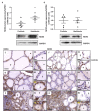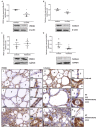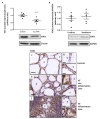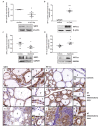Oxidative Stress-Induced Sirtuin1 Downregulation Correlates to HIF-1α, GLUT-1, and VEGF-A Upregulation in Th1 Autoimmune Hashimoto's Thyroiditis
- PMID: 33916948
- PMCID: PMC8067526
- DOI: 10.3390/ijms22083806
Oxidative Stress-Induced Sirtuin1 Downregulation Correlates to HIF-1α, GLUT-1, and VEGF-A Upregulation in Th1 Autoimmune Hashimoto's Thyroiditis
Abstract
In Hashimoto's thyroiditis (HT), oxidative stress (OS) is driven by Th1 cytokines' response interfering with the normal function of thyrocytes. OS results from an imbalance between an excessive production of reactive oxygen species (ROS) and a lowering of antioxidant production. Moreover, OS has been shown to inhibit Sirtuin 1 (SIRT1), which is able to prevent hypoxia-inducible factor (HIF)-1α stabilization. The aims of this study were to determine the involvement of NADPH-oxidases (NOX), SIRT1, and HIF-1α in HT pathophysiology as well as the status of antioxidant proteins such as peroxiredoxin 1 (PRDX1), catalase, and superoxide dismutase 1 (SOD1). The protein expressions of NOX2, NOX4, antioxidant enzymes, SIRT1, and HIF-1α, as well as glucose transporter-1 (GLUT-1) and vascular endothelial growth factor A (VEGF-A), were analyzed by Western blot in primary cultures of human thyrocytes that were or were not incubated with Th1 cytokines. The same proteins were also analyzed by immunohistochemistry in thyroid samples from control and HT patients. In human thyrocytes incubated with Th1 cytokines, NOX4 expression was increased whereas antioxidants, such as PRDX1, catalase, and SOD1, were reduced. Th1 cytokines also induced a significant decrease of SIRT1 protein expression associated with an upregulation of HIF-1α, GLUT-1, and VEGF-A proteins. With the exception of PRDX1 and SOD1, similar results were obtained in HT thyroids. OS due to an increase of ROS produced by NOX4 and a loss of antioxidant defenses (PRDX1, catalase, SOD1) correlates to a reduction of SIRT1 and an upregulation of HIF 1α, GLUT-1, and VEGF-A. Our study placed SIRT1 as a key regulator of OS and we, therefore, believe it could be considered as a potential therapeutic target in HT.
Keywords: HIF-1α; Hashimoto’s thyroiditis; NOX4; Sirtuin1; oxidative stress.
Conflict of interest statement
The authors declare no conflict of interest. Authors have nothing to disclose. No competing financial interests exist.
Figures







Similar articles
-
miR-199a Downregulation as a Driver of the NOX4/HIF-1α/VEGF-A Pathway in Thyroid and Orbital Adipose Tissues from Graves' Patients.Int J Mol Sci. 2021 Dec 23;23(1):153. doi: 10.3390/ijms23010153. Int J Mol Sci. 2021. PMID: 35008579 Free PMC article.
-
Downregulation of Caveolin-1 and Upregulation of Deiodinase 3, Associated with Hypoxia-Inducible Factor-1α Increase, Are Involved in the Oxidative Stress of Graves' Orbital Adipocytes.Thyroid. 2021 Apr;31(4):627-637. doi: 10.1089/thy.2020.0238. Epub 2020 Oct 28. Thyroid. 2021. PMID: 32977740
-
Nrf2 Activation Induced by Sirt1 Ameliorates Acute Lung Injury After Intestinal Ischemia/Reperfusion Through NOX4-Mediated Gene Regulation.Cell Physiol Biochem. 2018;46(2):781-792. doi: 10.1159/000488736. Epub 2018 Mar 29. Cell Physiol Biochem. 2018. PMID: 29621765
-
[The role of Th17 cells and IL-17 in Hashimoto's thyroiditis: Review].Xi Bao Yu Fen Zi Mian Yi Xue Za Zhi. 2024 Apr;40(4):373-377. Xi Bao Yu Fen Zi Mian Yi Xue Za Zhi. 2024. PMID: 38710521 Review. Chinese.
-
The interplay of oxidative stress and immune dysfunction in Hashimoto's thyroiditis and polycystic ovary syndrome: a comprehensive review.Front Immunol. 2023 Jul 31;14:1211231. doi: 10.3389/fimmu.2023.1211231. eCollection 2023. Front Immunol. 2023. PMID: 37588599 Free PMC article. Review.
Cited by
-
Saikosaponin-d Attenuates Hashimoto's Thyroiditis by Regulating Macrophage Polarization.J Immunol Res. 2022 Nov 8;2022:7455494. doi: 10.1155/2022/7455494. eCollection 2022. J Immunol Res. 2022. PMID: 36398316 Free PMC article.
-
The Influence of Micronutrients and Environmental Factors on Thyroid DNA Integrity.Nutrients. 2025 Jun 21;17(13):2065. doi: 10.3390/nu17132065. Nutrients. 2025. PMID: 40647171 Free PMC article. Review.
-
HIF-1α Regulates Bone Homeostasis and Angiogenesis, Participating in the Occurrence of Bone Metabolic Diseases.Cells. 2022 Nov 10;11(22):3552. doi: 10.3390/cells11223552. Cells. 2022. PMID: 36428981 Free PMC article. Review.
-
LncRNA-MCM3AP-AS1 Promotes the Progression of Infantile Hemangiomas by Increasing miR-138-5p/HIF-1α Axis-Regulated Glycolysis.Front Mol Biosci. 2021 Sep 29;8:753218. doi: 10.3389/fmolb.2021.753218. eCollection 2021. Front Mol Biosci. 2021. PMID: 34660700 Free PMC article.
-
In silico and in vivo demonstration of the regulatory mechanism of Qi-Ge decoction in treating NAFLD.Ann Med. 2023 Dec;55(1):2200258. doi: 10.1080/07853890.2023.2200258. Ann Med. 2023. PMID: 37096878 Free PMC article.
References
MeSH terms
Substances
LinkOut - more resources
Full Text Sources
Other Literature Sources
Miscellaneous

